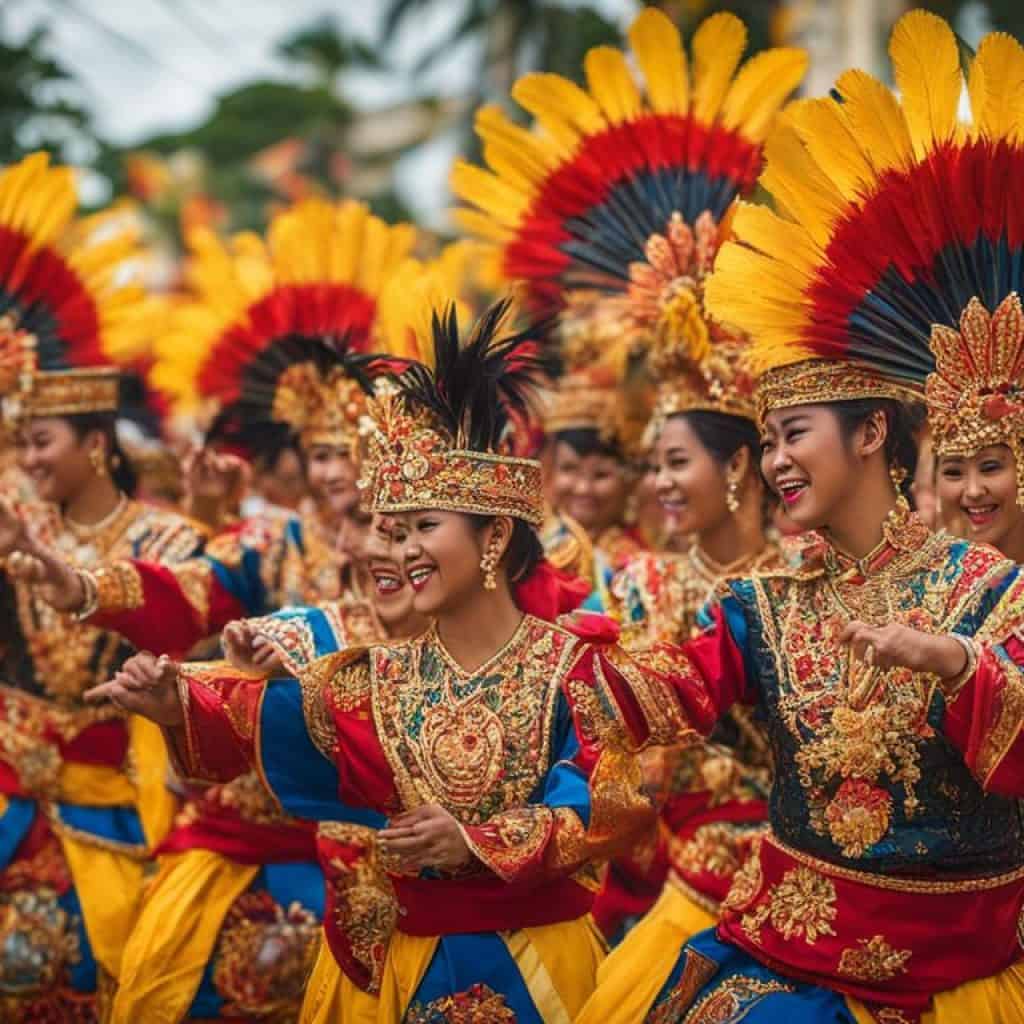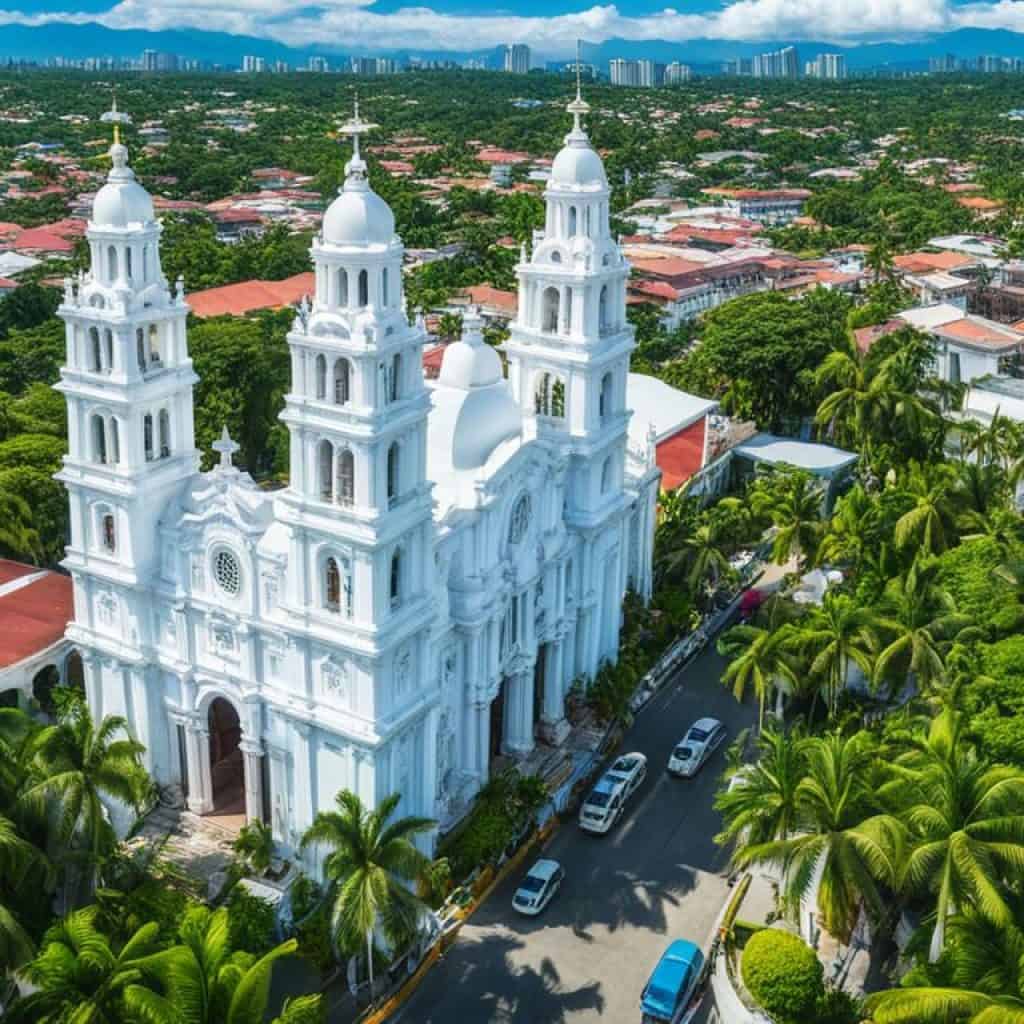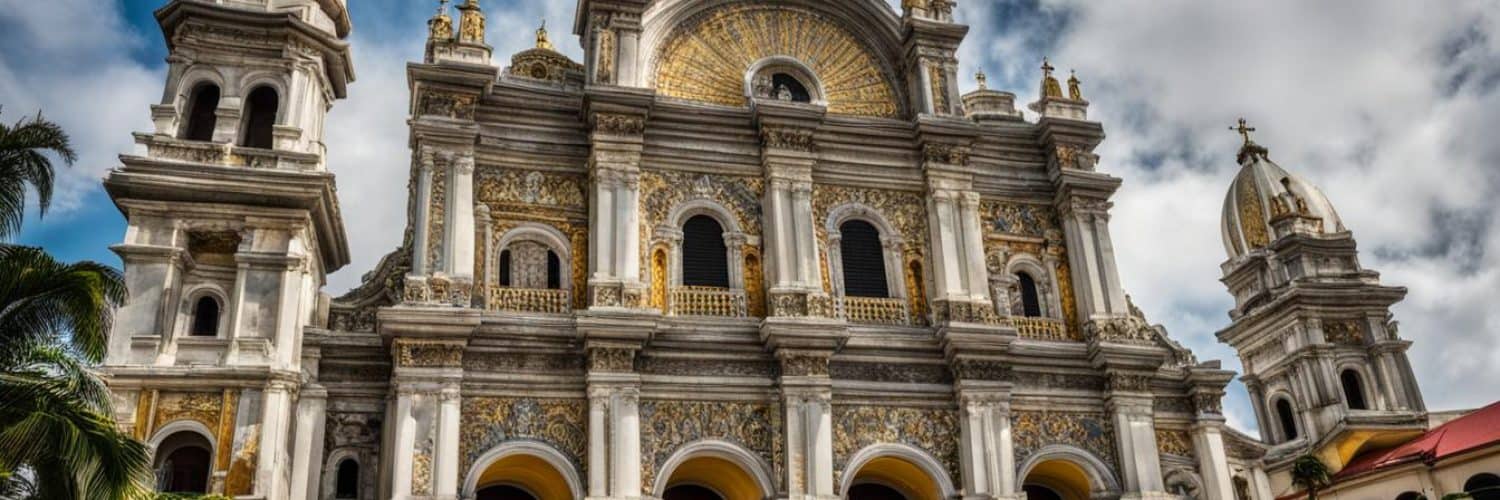Embark on a journey through time and devotion at the Santo Niño Basilica, one of the most cherished historic sites in Cebu. Nestled in the bustling heart of Cebu City, this awe-inspiring edifice stands as a testament to the enduring cultural heritage of the Philippines. Whether you are a history enthusiast or a spiritual seeker, the basilica offers an opportunity to explore the captivating blend of Cebu City tourist attractions and revered religious landmarks. Witness the majestic architecture and feel the hallowed ambiance of a site that continues to inspire visitors from around the world.
Key Takeaways
- Discover the cultural and historical significance of the Santo Niño Basilica, a must-see in Cebu City.
- Explore the beauty and serenity of one of the Philippines’ most significant religious landmarks.
- Learn about the rich cultural heritage linked to this iconic basilica and its impact on Filipino spirituality.
- Experience a sense of connection with the past through the architecture and artifacts housed within the basilica.
- Include the Santo Niño Basilica in your itinerary to gain a deeper understanding of Cebu’s history and cultural landscape.
Unveiling the Heritage of Basilica Minore del Santo Niño
The Basilica Minore del Santo Niño is not just a mere edifice; it’s a cornerstone of Philippine culture, embodying the profound significance of Santo Niño to the Filipino people. Beyond being a significant religious site, it also stands as a beacon of cultural heritage, drawing countless visitors to appreciate its historic church charm and its role in the propagation of Christianity across the archipelago.
The Significance of Santo Niño in Philippine Culture
Upon setting foot in the basilica, one is immediately engulfed by the warm embrace of history and devotion. The revered statue of the Santo Niño, a dark wooden sculpture of the Child Jesus, stands as an enduring symbol of the Christian faith’s introduction to the islands. Discovered by Spanish explorers in 1565, the image is more than just an object of veneration; it is a historic emblem that chronicles the Philippine’s colonial past and reflects its societal evolution.
Architectural Splendors of the Basilica
Converging vastly different architectural styles, the Basilica is a splendid showcase of Romanesque and neo-classicism. With its grandiose stone facade and distinctive domed ceiling that echoes Islamic architectural influence, the basilica is a treasure trove for connoisseurs of historic architecture and art. An in-depth exploration reveals a symphony of styles, each narrating a unique chapter of the island’s storied past.
| Architectural Element | Description | Cultural Influence |
|---|---|---|
| Stone Facade | Characteristic of Romanesque style, with weathered texture. | European influence reflecting the age of Spanish colonization. |
| Dome Ceiling | Muslim-influenced design presenting a unique dome shape. | Incorporates Muslim architectural techniques, symbolizing pre-colonial beliefs. |
| Museum Collection | Cherished antiquities and garments associated with the Santo Niño. | A rich narrative displaying artifacts that span centuries of religious heritage. |
In summary, the Basilica Minore del Santo Niño is a testament to the enduring spirit and profound historical consciousness of the Filipino people. It reflects an era that seamlessly blends religious dogmas and societal traditions, making it an unparalleled site of pilgrimage and a quintessential representation of the storied Filipino culture.
Exploring the Religious Landmark in Cebu City
Embarking on a journey to Cebu City allows the chance to visit the Basilica Minore del Santo Niño, a paramount religious landmark that has captured the hearts of many. This noteworthy historic church in the Philippines is a crossroad of faith and history, drawing countless visitors and pilgrims year-round.
Positioned at the heart of Cebu City, the basilica neighbors other significant attractions, creating a constellation of cultural and historical experiences. The presence of the revered Santo Niño de Cebu seals the church’s importance, marking the very origins of Christianity in the archipelago. Whether it’s the beauty of its architecture or the depth of its spiritual offerings, this locale resonates with those tracing their faith’s roots or exploring Cebu’s rich tapestry.
As one of the oldest catholic establishments in the region, it has seen generations of worshippers and curious minds come through its doors, seeking solace, wisdom, or simply a brush with the steadfast spirit of Cebu.
Magnet for Pilgrimages: The image of the Santo Niño, a representation of the young Jesus Christ, holds exceptional significance. Its historical narrative is indispensable to understanding pilgrimages made to this sacred site.
- Proximity to other attractions such as Magellan’s Cross and Cebu Metropolitan Cathedral accentuates the basilica’s allure.
- The regular influx of visitors turning to prayer and reflection inside the storied walls bear testimony to its undiminished religious importance.
- Annual celebrations and festivities around the basilica offer a glimpse into the vibrant Cebuano faith and heritage.
| Highlight | Details |
|---|---|
| Historical Significance | One of the foremost Catholic churches in Cebu, established following the arrival of Christianity. |
| Religious Importance | Home to the Santo Niño de Cebu, regarded as miraculous and pivotal in religious observances. |
| Architectural Splendor | Aesthetically significant structure showcasing a mixture of design elements from various eras. |
| Cultural Experience | A point of convergence during major festivities, notably the Sinulog Festival. |
The story of Cebu, its devotion, and cultural fabric cannot be fully told without mention of the Basilica Minore del Santo Niño. Its towers not only reach up to the sky but deep into the heart of Cebuanos and the many travelers who venture to this historic corner of the world.
A Pilgrim’s Journey to the Santo Niño de Cebu
Embarking on a religious journey to the Basilica Minore del Santo Niño is a pilgrimage steeped in profound cultural and spiritual significance. For centuries, this historic site has beckoned devotees from all corners, inviting them into a realm where faith intertwines with vibrant Philippine culture.
Experience the Tradition of Sinulog Dance
The heart of the pilgrimage is undoubtedly the Sinulog Festival, a jubilant celebration that engulfs Cebu City with its colorful splendor. The Sinulog dance is a mesmerizing spectacle; rhythmic drum beats echo as dancers adorned in resplendent costumes move to the heartbeat of the city, their movements a tribute to the Santo Niño de Cebu. This annual event infuses the air with spirituality and the shared joy of devout attendees expressing their veneration through dance.

Admiring the Sacred Artifacts and Museum Collections
Within the revered walls of the basilica lies a treasure trove of history—the museum’s esteemed sacred artifacts and museum collections. Here, pilgrims and visitors can delve into the enduring legacy of the Santo Niño, tracing the religious journey of the Filipino people. The collections encompass historical items and ecclesiastical garments that tell a narrative of resilience, devotion, and the unbroken thread of faith that weaves through the fabric of the Philippine pilgrimage experience.
Basilica Minore del Santo Niño, Cebu Philippines: A Testament to Resilience
The Basilica Minore del Santo Niño in Cebu Philippines not only stands as a revered historical site and pivotal religious landmark but also as a powerful testament to resilience. Its storied past chronicles the unyielding spirit of a community dedicated to preserving its cultural and religious heritage. Initially constructed in 1566 from simple materials, this sanctified edifice has risen from the ashes of adversity multiple times throughout its long history.
From its modest beginnings, the basilica underwent several reconstructions in response to trials by fire and the ravages of natural calamities. Yet, with each instance of destruction came a period of renewed strength and determination. The current structure signifies not only a return to former glory but an enhancement over its original form. Completed with the solidity of hewn stones in 1739, it has remorselessly weathered the tests of time.
Enshrined within its walls is the miraculous Sto. Niño image, which has admirably survived these tribulations, further solidifying the basilica’s esteemed status. Many believe the image’s preservation during such tumultuous periods to be nothing short of a miracle, representing the steadfast faith of the Filipino people. This sanctuary, thus, embodies an enduring source of spiritual inspiration and a beacon of the Filipino spirit.
Witnessing Faith and Devotion at the Historic Basilica
The Basilica Minore del Santo Niño, with its majestic standing as a historic basilica and pilgrimage site, invites both the faithful and curious to partake in its spiritual journey. Faith and devotion palpably fill the air as visitors and worshippers come together to experience the sanctity and tradition that the basilica has upheld for centuries. Through mass celebrations and vibrant religious festivities, the spirit of Cebu City and its people shines brightly.
Celebrating Mass at the Pilgrimage Site
In the hallowed walls of this religious landmark, mass celebrations represent a core component of the daily rhythm. Catering to the multilingual congregation, the basilica thoughtfully conducts services in both Cebuano and English. This inclusive approach ensures that every devotee, whether local or from distant shores, feels embraced by the community of faith. The rituals and prayers observed here resonate with a profound sense of devotion, steeped in the cultural heritage of Cebu City.
Participating in Religious Festivities and Events
Among the most famed religious festivities is the Sinulog Festival, a dynamic expression of Cebu City celebrations. This exuberant event encapsulates Philippine tradition, where dancers clad in vibrant hues move rhythmically to the beat of the drums, their movements a homage to the Santo Niño. The historic basilica serves as the epicenter for this and many other events throughout the year, each festivity echoing the enduring faith and unity of its people. The collective fervor of these events not only stir the soul but also knit the fabrics of history, culture, and devotion into an unforgettable experience.
Integrating Culture and Faith at a Philippinian Basilica
The Basilica Minore del Santo Niño in Cebu is not just a testament to the cultural heritage of the Philippines; it’s a vibrant tourist attraction where the integration of culture and faith comes to life. This Philippinian basilica serves as a bridge between the past and present, inviting visitors from around the world to explore one of the most significant Cebu historical sites. The Basilica stands as a powerful symbol of unity, reflecting how religion and local customs have coalesced to form the unique identity of Cebu’s community.

Within its hallowed walls and amid its soaring arches, stories of both conquest and amalgamation are recounted through art, architecture, and the enduring traditions practiced by its parishioners. To fully grasp the depth of this integration, one must consider the religious events and cultural festivities that are regularly celebrated here, each a thread in the colorful fabric of Cebuano life.
Here, at the Basilica Minore del Santo Niño, we see the harmonious blend of faith and culture that is intrinsic to the Philippine spirit. The basilica is not merely a structure; it is a living, breathing entity that continues to nurture the soul of this island.
Let us delve into the vibrant tableau that depicts the integration of culture and faith at this celebrated basilica:
| Cultural Element | Manifestation of Faith | Historical Significance |
|---|---|---|
| Architectural Design | Spanish Colonial and Romanesque structures | Reflects the Spanish influence on Philippine religion and society |
| Art and Imagery | Province’s patron, the Sto. Niño de Cebu | Symbolizes the Christianization of the Philippines |
| Festivities | Sinulog Festival | Combines Catholic ritual with pre-Christian Philippine culture |
| Museum Collections | Relics and historical artifacts | Preserves the legacy of the church and its impact on Filipino history |
Each visit to the Basilica Minore del Santo Niño is an immersive encounter with the sacred and the societal, an experience that stays with the visitor long after they have left its storied grounds. This historic site is a shining example of how a Philippinian basilica not only stands as a place of worship but also as a hub of cultural assimilation and continuity.
Essential Travel Tips for Visiting the Basilica Minore del Santo Niño
Embarking on a spiritual journey to the heart of Cebu City invites you to witness a fusion of history and devotion. Here are essential travel tips to ensure a profound experience when visiting Santo Niño Basilica.
Best Times to Visit and What to Expect
For an enriched travel experience, plan your visit to the Basilica Minore del Santo Niño during the winter months. Not only is the weather pleasant, but you’ll also have the opportunity to partake in the Sinulog Festival—an event bursting with cultural displays and religious fervor. The basilica is a beacon of spirituality and history, open to visitors year-round, offering mass services and the chance to delve into the deep-rooted traditions of Cebu.
Navigating Cebu City: Reaching the Historical Site
Discovering the Basilica is an integral part of exploring Cebu’s historical landmarks. Navigating Cebu City is a breeze with public transportation, particularly jeepneys traveling to and from key locations. Here’s a simple guide to help you reach this historic site:
| Starting Point | Jeepney Route | Landmarks Along the Way |
|---|---|---|
| Ayala Center Cebu | Route 14D | Provincial Capitol, Fuente Osmeña Circle |
| SM City Cebu | Route 12L | North Reclamation Area, Pier 1 |
| IT Park Lahug | Route 17B | Waterfront Cebu City Hotel, Cebu Country Club |
Strategically situated near other prominent sites like Magellan’s Cross, a visit to the Basilica blends perfectly with a day of touring other historical markers. Use these travel tips to help plan a smooth and memorable visit to one of Cebu’s most revered landmarks.
Around the Basilica: Engaging with Cebu’s Local Charms
Just a stone’s throw away from the reverent walls of the Basilica Minore del Santo Niño, Cebu City opens its arms to visitors, offering a vibrant mix of cultural experiences. The city’s local charms extend beyond its historic sites, engaging tourists with its unique blend of culinary and shopping adventures set against the backdrop of Cebu culture.
Discovering Nearby Tourist Attractions in Cebu City
As you step out from the spiritual tranquility of the basilica, a world of exploration awaits. The Casa Gorordo Museum gives a glimpse into the opulent Spanish-colonial lifestyle, while Fort San Pedro tells the tale of battles and historical defenses. But there’s more—take a walk and bask in the grandeur of the Cebu Metropolitan Cathedral or find serenity at the tranquil Chinese Taoist Temple, both emblematic of the diversity of tourist attractions in Cebu City.
Culinary Delights and Souvenir Shopping
No visit to Cebu City would be complete without indulging in the culinary delights it has to offer. From the sizzling lechon known to be the best in the Philippines to the sweet treat of mangoes preserved in all their glory, the flavors here are sure to tantalize your taste buds. After satisfying your appetite, engage in souvenir shopping, where you can find authentic handcrafted items that capture the spirit of Cebu culture—perfect for bringing home a piece of this enchanting region.
Witness Cebu’s captivating blend of history, food, and artisanal crafts that make it a treasured destination for any traveler.
| Local Attraction | Experience | Noteworthy Souvenir |
|---|---|---|
| Casa Gorordo Museum | Historic Home Insight | Reproduction Antique Pieces |
| Fort San Pedro | Military History Tour | Miniature Fort Models |
| Cebu Metropolitan Cathedral | Spiritual Sanctuary | Religious Icons |
| Chinese Taoist Temple | Intercultural Encounter | Traditional Chinese Décor |
| Local Food Markets | Culinary Adventure | Gourmet Dried Mangoes |
Whether you’re immersing yourself in the richness of Cebu’s history or savoring the flavors woven into its cuisine, your journey around the Basilica Minore del Santo Niño is sure to be a feast for the senses. Discover the local charms that make Cebu City a treasure trove of experiences, both memorable and authentically Filipino.
Conclusion
Immersed in the vibrant history of Cebu Philippines, the Basilica Minore del Santo Niño transcends its role as a mere historic religious site. It embodies the profound cultural significance that connects visitors to the heart of Philippine spirituality and community. The architecture, the sacred artifacts, and the rhythm of prayer within its walls paint a living picture of the country’s cultural exploration and religious expression. From the cherished Sinulog festival to the solemnity of its masses, the basilica is both a sanctuary and a jubilant center of faith.
For those seeking a journey rich in history and personal reflection, this cherished monument offers an unparalleled experience. The resilience of its structure mirrors the enduring spirit of the people and their faith. The legacy of the Sto. Niño de Cebu, housed within its ancient stones, continues to inspire faith and devotion. As a gatekeeper to the cultural soul of Cebu, the basilica stands as a testament to the Philippines’ colorful and devout heritage, beckoning explorers to its doors.
Indeed, a visit to the Basilica Minore del Santo Niño is more than a sightseeing endeavor; it is a step into the living tapestry of Cebu’s cultural and spiritual life. Both locals and tourists find common ground in the reverence and beauty this iconic basilica commands. Journeying through this profound site not only enlightens one on the historic dimensions of Cebu but also offers a transformative glimpse into the harmonious blend of culture and faith that has shaped this vibrant archipelago.
FAQ
What is the historical significance of the Santo Niño Basilica in Cebu?
The Santo Niño Basilica, also known as Basilica Minore del Santo Niño, is a landmark of great historical and religious significance. It is home to the revered relic of the Sto. Niño de Cebu, which symbolizes the introduction of Christianity in the Philippines. The basilica stands as a testament to the cultural heritage and the deep-rooted faith of the Filipino people.
Can you describe the architectural style of the Basilica Minore del Santo Niño?
The architecture of the Basilica Minore del Santo Niño is a blend of Romanesque and neoclassical styles, with intricate designs and a distinct Muslim influence seen in its dome-like ceiling. Its elegant edifice showcases the rich cultural heritage and historical narrative of Cebu, making it a significant religious site and architectural splendor.
Is the Basilica Minore del Santo Niño still used for religious services?
Yes, the Basilica Minore del Santo Niño remains an active site for Catholic worship. Regular masses are held in both Cebuano and English, catering to the local community as well as international visitors. It is a vibrant center for faith and devotion, deeply intertwined with the daily lives of its parishioners.
What are some unique cultural experiences to enjoy at the Basilica?
Visitors can experience the rich culture of Cebu through the Basilica’s connection to the Sinulog dance and festival, which honors the Sto. Niño. The annual Sinulog Festival, occurring every January, features colorful parades and traditional performances. Additionally, the basilica’s museum offers an insight into the sacred artifacts and historical items relevant to Philippine religious history.
How has the Basilica Minore del Santo Niño shown resilience over the years?
The Basilica Minore del Santo Niño has endured numerous reconstructions after suffering from fires and natural calamities since its original establishment in 1566. Each restoration effort has fortified the structure, transitioning from its initial wood and nipa composition to the more enduring hewn stone construction completed in 1739. Its ability to withstand these challenges is a significant reflection of the resilience inherent in the site’s historical narrative.
Are there any special events or festivities at the Basilica?
Yes, the Basilica Minore del Santo Niño hosts various religious events and festivities throughout the year, the most prominent being the Sinulog Festival. This and other celebrations, such as those dedicated to the patron saint, showcase the rich traditions, faith, and community spirit that bind the people of Cebu.
How does the Basilica integrate culture and faith?
The Basilica Minore del Santo Niño is an epitome of the integration of culture and faith in the Philippinian context. It stands as a historical site where pivotal moments in Cebu’s history are commemorated, and it continues to be a place where art, spirituality, and community converge.
When is the best time to visit the Basilica, and what should visitors expect?
The best time to visit the Basilica Minore del Santo Niño is during the winter months, especially around the time of the Sinulog Festival in January, which is a vibrant celebration of Cebu’s cultural and religious heritage. Visitors should expect a bustling atmosphere with devotees and tourists, and they are encouraged to respect the religious practices and the sanctity of the site.
How can someone get to the Basilica Minore del Santo Niño?
The basilica is easily accessible via public transportation within Cebu City. Jeepneys, which are local buses, offer routes that connect major points of the city to the basilica. For tourists staying in the city center, the Basilica is typically within walking distance from many hotels and other cultural sites.
What other attractions and activities are available near the basilica?
Beyond visiting the Basilica, tourists can engage with local charms by exploring nearby historical attractions including Magellan’s Cross, Fort San Pedro, and the Casa Gorordo Museum. They can also indulge in the culinary delights that Cebu has to offer and shop for souvenirs reflecting the rich cultural tapestry of the region.
Source Links
- https://www.tripadvisor.com/Attraction_Review-g298460-d15277238-Reviews-Basilica_Minore_del_Sto_Nino_de_Cebu-Cebu_City_Cebu_Island_Visayas.html
- https://www.asiatours.com/experiences/basilica-of-santo-nino.html
- https://guidetothephilippines.ph/destinations-and-attractions/basilica-minore-del-santo-nino











Add comment